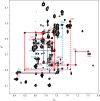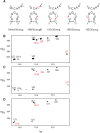Analysis of intermolecular base pair formation of prohead RNA of the phage phi29 DNA packaging motor using NMR spectroscopy
- PMID: 18084020
- PMCID: PMC2241910
- DOI: 10.1093/nar/gkm874
Analysis of intermolecular base pair formation of prohead RNA of the phage phi29 DNA packaging motor using NMR spectroscopy
Abstract
The bacteriophage ø29 DNA packaging motor that assembles on the precursor capsid (prohead) contains an essential 174-nt structural RNA (pRNA) that forms multimers. To determine the structural features of the CE- and D-loops believed to be involved in multimerization of pRNA, 35- and 19-nt RNA molecules containing the CE-loop or the D-loop, respectively, were produced and shown to form a heterodimer in a Mg2+-dependent manner, similar to that with full-length pRNA. It has been hypothesized that four intermolecular base pairs are formed between pRNA molecules. Our NMR study of the heterodimer, for the first time, proved directly the existence of two intermolecular Watson-Crick G-C base pairs. The two potential intermolecular A-U base pairs were not observed. In addition, flexibility of the D-loop was found to be important since a Watson-Crick base pair introduced at the base of the D-loop disrupted the formation of the intermolecular G-C hydrogen bonds, and therefore affected heterodimerization. Introduction of this mutation into the biologically active 120-nt pRNA (U80C mutant) resulted in no detectable dimerization at ambient temperature as shown by native gel and sedimentation velocity analyses. Interestingly, this pRNA bound to prohead and packaged DNA as well as the wild-type 120-nt pRNA.
Figures








Similar articles
-
Prohead RNA: a noncoding viral RNA of novel structure and function.Wiley Interdiscip Rev RNA. 2016 Jul;7(4):428-37. doi: 10.1002/wrna.1330. Epub 2016 Jan 25. Wiley Interdiscip Rev RNA. 2016. PMID: 26810250 Free PMC article. Review.
-
Role of the CCA bulge of prohead RNA of bacteriophage ø29 in DNA packaging.J Mol Biol. 2008 Nov 14;383(3):520-8. doi: 10.1016/j.jmb.2008.08.056. Epub 2008 Aug 29. J Mol Biol. 2008. PMID: 18778713 Free PMC article.
-
In vitro selection of bacteriophage phi29 prohead RNA aptamers for prohead binding.J Biol Chem. 1998 Jan 30;273(5):2947-53. doi: 10.1074/jbc.273.5.2947. J Biol Chem. 1998. PMID: 9446607
-
Modular assembly of chimeric phi29 packaging RNAs that support DNA packaging.Biochem Biophys Res Commun. 2008 Aug 8;372(4):589-94. doi: 10.1016/j.bbrc.2008.05.094. Epub 2008 Jun 2. Biochem Biophys Res Commun. 2008. PMID: 18514064 Free PMC article.
-
Implication of the prohead RNA in phage phi29 DNA packaging.Biochimie. 2002 Sep;84(9):945-51. doi: 10.1016/s0300-9084(02)01444-x. Biochimie. 2002. PMID: 12458086 Review.
Cited by
-
Prohead RNA: a noncoding viral RNA of novel structure and function.Wiley Interdiscip Rev RNA. 2016 Jul;7(4):428-37. doi: 10.1002/wrna.1330. Epub 2016 Jan 25. Wiley Interdiscip Rev RNA. 2016. PMID: 26810250 Free PMC article. Review.
-
DNA/RNA hybrids avoid channel gating that leads to the continued packaging of numerous hybrids into the phi29 protein shell.Nucleic Acids Res. 2025 Mar 20;53(6):gkaf242. doi: 10.1093/nar/gkaf242. Nucleic Acids Res. 2025. PMID: 40193705 Free PMC article.
-
Different sequences show similar quaternary interaction stabilities in prohead viral RNA self-assembly.J Biol Chem. 2011 Apr 22;286(16):14419-26. doi: 10.1074/jbc.M110.191064. Epub 2011 Feb 24. J Biol Chem. 2011. PMID: 21349846 Free PMC article.
-
Structure and assembly of the essential RNA ring component of a viral DNA packaging motor.Proc Natl Acad Sci U S A. 2011 May 3;108(18):7357-62. doi: 10.1073/pnas.1016690108. Epub 2011 Apr 6. Proc Natl Acad Sci U S A. 2011. PMID: 21471452 Free PMC article.
-
Structural features of a 3' splice site in influenza a.Biochemistry. 2015 Jun 2;54(21):3269-85. doi: 10.1021/acs.biochem.5b00012. Epub 2015 May 21. Biochemistry. 2015. PMID: 25909229 Free PMC article.
References
-
- Grimes S, Jardine PJ, Anderson D. Bacteriophage phi 29 DNA packaging. Adv. Virus Res. 2002;58:255–294. - PubMed
-
- Guo PX, Erickson S, Anderson D. A small viral RNA is required for in vitro packaging of bacteriophage phi 29 DNA. Science. 1987;236:690–694. - PubMed
-
- Zhang F, Lemieux S, Wu X, St-Arnaud D, McMurray CT, Major F, Anderson D. Function of hexameric RNA in packaging of bacteriophage phi 29 DNA in vitro. Mol. Cell. 1998;2:141–147. - PubMed
Publication types
MeSH terms
Substances
Grants and funding
LinkOut - more resources
Full Text Sources
Research Materials
Miscellaneous

